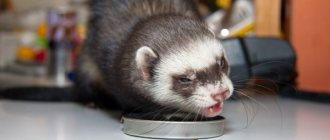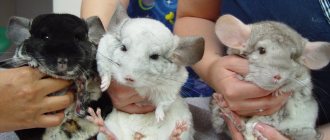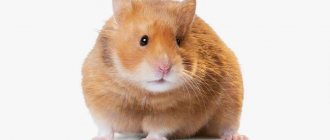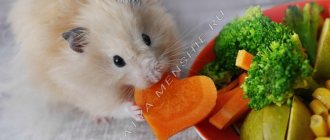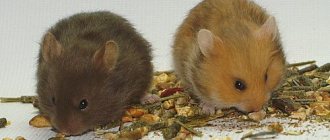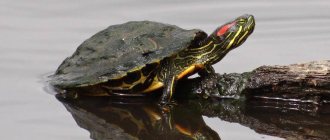- General Content Rules
- Required and permitted products
- Dry food, cereals
- Fruits, berries
- Vegetables
- Green feed
- tree branches
Djungarian hamsters are one of the most beloved, good-natured, charming pets to keep at home.
They quickly get used to being handled and almost never bite. Very tiny, no more than 7-10 centimeters in length, they are significantly smaller in size than Syrians, unpretentious, and do not require special attention. It is important to remember: proper care and feeding are the key to good health and long life of a rodent. Under natural conditions, the animals do not live long, barely reaching one and a half years. The reason for this is disease, poor nutrition, and predators that hunt hamsters. A calm home environment, absence of stress and illness prolongs life to 3 years or more.
The opinion is that dzhungarikas can eat anything. Although they look like mice, they are not nearly as tough. Fat girls constantly gnaw, not refusing any food offered. But only high-quality food and the right menu will help ensure a good mood for hamsters and maintain health. When getting a small rodent, owners need to familiarize themselves with the rules for keeping dwarf hamsters and find out what to feed dwarf hamsters at home.
What to feed the dwarf: list
Let's get straight to the point. Below is a table that describes:
- What can you give your Djungarian hamster?
- What not to do
- What is possible, but carefully
Be sure to read to the end and understand why it is allowed to feed some things to the dwarf, but others are strictly prohibited. And how does this affect the health and life expectancy of the Djungarian pet.
| What can and cannot be done for dzhungarik | |
| Cereals and flour | |
| Can | Oats |
| Wheat | |
| Barley | |
| Rye | |
| It is forbidden | Pasta |
| Bread and baked goods | |
| Confectionery | |
| It's possible, but be careful | Rice |
| Buckwheat | |
| Lentils | |
| Corn | |
| Seeds and nuts | |
| It is forbidden | Brazilian nut |
| Almond | |
| Pine nuts | |
| Fruit pits and seeds | |
| Acorns | |
| Chestnuts | |
| It's possible, but be careful | Sunflower seeds |
| Pumpkin seeds | |
| Flaxseeds | |
| Cashew | |
| Sesame | |
| Walnut | |
| Hazelnut | |
| Peanut | |
| Vegetables | |
| Can | Eggplant |
| Broccoli | |
| bell pepper | |
| Radish | |
| Turnip | |
| Cucumber | |
| Jerusalem artichoke | |
| It is forbidden | Watermelon |
| Melon | |
| Potato | |
| Sweet potato | |
| Onion | |
| Garlic | |
| It's possible, but be careful | Zucchini |
| Tomato | |
| Radish | |
| Celery | |
| Asparagus | |
| Carrot | |
| Pumpkin | |
| Cabbage | |
| Fruits | |
| Can | Apple |
| Pear | |
| It is forbidden | Persimmon |
| Citrus fruits (orange, grapefruit, tangerine) | |
| Exotic fruits (pineapple, kiwi, mango, pomegranate) | |
| It's possible, but be careful | Apricot |
| Peach | |
| Plum | |
| Berries | |
| Can | Barberry |
| Hawthorn | |
| Cowberry | |
| Pitted cherry | |
| Strawberries and wild strawberries | |
| Raspberries | |
| Sea buckthorn | |
| Rowan | |
| Currant | |
| Rose hip | |
| It is forbidden | Honeysuckle |
| Elder | |
| Sweet grapes | |
| It's possible, but be careful | Unsweetened grape varieties |
| Greenery | |
| Can | Any salad (iceberg, corn) |
| Clover | |
| Nettle | |
| Dandelions | |
| Plantain | |
| It is forbidden | Sorrel |
| Onion and garlic shoots | |
| It's possible, but be careful | Parsley |
| Dill | |
| Animal protein | |
| Can | Cottage cheese 1% fat |
| Low-fat white yogurt | |
| Boiled egg white | |
| Boiled beef | |
| Boiled chicken breast | |
| Boiled rabbit | |
| It is forbidden | Sausage |
| Raw meat or fish | |
| Milk | |
| Cheese | |
| Mushrooms | |
| It's possible, but be careful | Boiled white fish |
| Peeled boiled shrimp | |
| Gammarus |
In the “possible, but careful” column there are foods that should be given to dzhungarika no more than 1-2 times a week.
Do you want to give your hamster true culinary pleasure? :) Then read on what Djungarian hamsters readily eat.
Proper diet: composition
The basis of the rodent diet is cereals. It is advisable to give fresh and dried grass every 2 days, because in the steppe greens are the hamster’s main food in the summer. Vegetables and fruits are a small part of the diet, no more than 5% of food consumed. To be healthy, rodents need animal protein, which makes up a small proportion of their diet. Increasing the amount of meat and dairy foods is useful during pregnancy or breastfeeding.
Nuts and seeds are a treat, they should be given a little and no more than 2-3 times a week.
Possible problems in the diet of dzhungarika
The Djungarian hamster is a tiny animal (the average weight of an adult is about 50 g). This somewhat shortens the list of what you can feed your pet: what is good for other rodents, but death for the dzhungarika. For example, almonds contain hydrocyanic acid, which is harmless for a larger pet, but can easily poison your hamster.
The second important point is that Djungarians are prone to obesity and diabetes. They should not be overfed, given sweets, or fed flour or very sweet fruits. Despite the fact that they love to eat, we put them on a strict diet.
I can handle it, I can handle it without cookies!
Features of the body
Biology
The homeland of these animals is dry steppes and semi-deserts. Their digestive tract is not adapted to fatty, high-calorie, sweet foods. What dungarians eat in nature is a guideline for proper feeding of ornamental pets.
Wild hamsters feed mainly on grains and seeds. In the fall, the thrifty rodent seals the entrance to the hole, so in winter they only have access to dry food from reserves. In the spring they feed on green grass; in the summer, if possible, they feast on berries and insects.
The diet of a Djungarian hamster should consist of 65% carbohydrates, 16% protein, and 4-5% fat.
Like other rodents, Djungarians grow teeth throughout their lives. It is necessary to give the animal the opportunity to grind them down.
Metabolism
The main distinguishing feature of dzhungariks is their tiny size. This explains the high metabolic rate. Dwarf hamsters have a very fast metabolism and cannot go hungry. Compared to its larger counterparts, the dzhungarik is very gluttonous - it eats up to 70% of its own weight per day.
Predisposition to diseases:
- diabetes;
- obesity.
Overeating is the most common cause of metabolic disorders in hamsters. You should not feed your pet just for fun or because he is standing on his hind legs. Animals already choose the most delicious components from the food, which are also the most high-calorie. In confined spaces, care and feeding should be aimed at preventing excess weight.
The animal must be allowed out for a walk, active games are encouraged, and a running wheel is placed in the cage. Djungarian hamsters are fed a maximum of twice a day.
Diabetes mellitus is a consequence of obesity and genetic predisposition. Campbell's hamsters often suffer from this disease, but the difficulty is that in pet stores they uncontrollably crossbreed with Djungarian hamsters. An owner who does not purchase a rodent from professional breeders cannot be sure that it is not a hybrid.
Purposefully excluding foods rich in sugar from the Djungarian hamster's menu will only benefit the pet.
Basic nutrition of the Djungarian hamster
In nature, the Djungarian hamster's diet consists mainly of seeds and cereals. Therefore, it is reasonable to feed the dwarf at home according to the same principle.
The ideal option is to feed ready-made food for Djungarian hamsters. All the necessary grains, seeds, and dried herbs are already mixed there. Often the manufacturer enriches the feed with minerals, trace elements and vitamins.
This mixture can be given to dzhungarika constantly, periodically adding fresh vegetables, fruits and berries (in season), plus protein (more on that below). But if for some reason you cannot feed ready-made food, then here is a detailed video on the topic “how to prepare food yourself.”
Special cases
Weak, elderly animals
Sick and elderly hamsters should receive similar diets.
For weakened animals, grain feed, baby purees and cereals, ground to a mushy state, are suitable. It is convenient to hide medicine in such food.
Young hamsters
Young hamsters need more food, since their energy is spent not only on active games, but also on body growth. Baby food is perfect for newborn hamsters: fruit, meat or vegetable purees, dairy-free porridge. You will have to feed the baby with a pipette.
What else can Djungarian hamsters eat?
- Fruits (not exotic, but “local”) - eat no more than a couple of times a week, preferably 1.
- If your dry food does not contain greens, you can add them to the diet (dried).
- Non-starchy vegetables (cucumber, bell pepper) - can be eaten almost every day, alternating.
- Low-starch vegetables (zucchini, carrots, pumpkin) - it is enough to feed them to the dwarf 2 times a week.
- Protein – 1-2 times a week.
- Nuts, seeds - try to give them less often, as a treat (high fat content of the product).
The main emphasis in nutrition is on grains.
What fruits and berries can hamsters eat?
Fruits for the Djungarian hamster should not be too sweet (remember about diabetes!). It is for this reason that you should not feed the dzhungarik exotic foods at all. Occasionally, you can give a dried banana, but not more than once a week (formally, a banana is a berry, but that’s what we’re used to).
Be sure to remove large seeds and pits from the fruit. Many of them can be poisonous to the dwarf. The possibility that such a baby will simply choke on the seeds cannot be ruled out either.
Follow the same recommendations when choosing berries.
Lifehack. Use glycemic index tables for foods. Those with a high indicator should never be fed to the Djungarian hamster.
A few words about dried fruits. These are the same fruits, only the water has been removed from them. The composition remains virtually unchanged; we feed according to the same principles as fresh fruit.
Choose fruits that are as sweet as possible for your pet.
What vegetables can dzungaria eat?
Vegetables have the same problem - they increase the risk of diabetes. Here we are no longer talking about sweets (fructose), but about starch, which “works” in the same way as fructose or sugar - it increases the level of glucose in the blood.
Therefore, try to feed your hamster vegetables that are low in starch and high in fiber.
The less starch in vegetables, the better.
What do hamsters prefer from greens?
For greens, let's eat your usual salad, parsley and dill (1-2 times a week). From “improvised” (more precisely, pasture) plants, you can feed plantains and dandelions. Greens are a storehouse of vitamins, microelements and nutrients for the Djungarian rodent, do not neglect them.
Avoid greens that have a strong smell or taste. Those. any plants that have an imbalance in composition (too many essential oils or acids). That is why it is strictly forbidden to feed the Djungarian hamster with onion sprouts, garlic and sorrel.
Don't forget about greens - very healthy.
Animal protein for the carnivorous dwarf
In its natural environment, the dzhungarik is by no means a vegetarian, and is not averse to sometimes eating what passes by. These are mainly insects. Therefore, for proper nutrition, you need to add protein foods to your hamster’s menu.
Ideal for:
- Boiled egg whites
- Skim cheese
- Boiled white fish
- Lean boiled meat of other animals (beef, chicken, turkey)
You can feed protein once a week (pregnant and lactating females, babies - more often, but we have a separate conversation about this).
I'm a predator!!! Strong!!! But easy...
Prohibited foods can be deadly
Risk of poisoning
Poisoning is extremely dangerous for dzungarians. If poison enters the body, death can occur within a few hours. If poisoning occurs gradually, the animal may suffer for up to several days. The most common cause of poisoning is:
- poisonous seeds that got into grain feed;
- spoilage of the mixture by pests, the presence of mold, pathogenic bacteria in it;
- ingestion of poisonous plants;
- chemicals in greens;
- rot in vegetables, fruits;
- improper storage of feed.
Cause constipation
If the amount of droppings has decreased, it has become dry and hard, the hamster’s tummy is swollen, the pet is restless, and may be constipated. Its cause is most often a disruption of the intestines, insufficient consumption of fiber and moisture in the body. Trauma, stress, and pathological conditions can also provoke this state.
Constipation can be caused by:
- quince,
- pear,
- rice,
- legumes,
- canned meat.
Causes diarrhea
The cause of diarrhea in Djungarians is most often an infection, but a similar reaction to certain foods is also possible.
- citrus,
- onion,
- garlic,
- beet,
- almond.
In addition, diarrhea can be caused by a sudden change in diet, the introduction of a new product, spoiled food, or overeating. Sometimes foreign objects (small buttons, beads) enter the body while walking around the house. In this case, it is important to immediately consult a veterinarian.
Cause fermentation
For a small animal, fermentation in the gastrointestinal tract is a serious problem that leads to a significant deterioration in health. You should avoid introducing the following foods into your animal’s diet:
- potatoes,
- legumes,
- cabbage,
- sour berries
- black bread,
- sweets,
- flour products.
Legumes in general can be present in limited quantities in the diet of the dwarf, provided that the body of a particular individual is able to digest them normally.
Too fat
Hamsters are cute creatures that most owners (and more often their guests) have a regular desire to pamper. Moreover, products are chosen that seem especially tasty to the person himself. This is exactly what happens with baked goods, a variety of salty crackers, chips, puff pastries, and cheeses. Due to their high fat content, such products should not be included in the diet. Guests should be warned about this immediately to avoid troubles with the pet’s health.
Cheek pouches hurt
Some products are not dangerous, but can cause problems due to the tiny size of the dwarf and its habits. The sharp edges or hard texture of the product may cause sores on the inside of the cheek pouches. It is for these reasons that you should not give your hamster dry pasta or seeds with sharp edges (it is better to clean them).
Allergy risk
Most often, allergic reactions occur to fruits, berries, and vegetables with bright colors. You may develop a similar intolerance to certain foods due to too frequent consumption. Signs of problems may include the appearance of redness on the skin, the animal's constant desire to scratch, and watery eyes. Most often, allergies occur to strawberries, cheeses, and exotic fruits.
How to feed a Djungarian hamster
How many times a day should you feed the animal? Djungarians are nocturnal (like other hamsters), so the main meal should be in the evening. You can feed food only once a day, but it wouldn’t be a mistake to feed it twice (in this case, let’s eat 70% of the daily amount in the evening, and 30% in the morning). This is not done for gorging before bed, but so that during the day, when the animal periodically wakes up, it has something to eat - the dwarf has a very fast metabolism (an eternally hungry hamster).
An adult Djungarian hamster only needs a tablespoon of food per day (with a small heap). Even if the food quickly disappears from the bowl, this is not a reason to feed more: most likely, your pet took everything that it didn’t eat into the pantry in order to “hamster” it later. It is his instinct to stock up.
Add more rash or I’ll bite your nose off!
Don't forget to promptly remove leftover perishable foods, otherwise they will begin to rot in the pantry.
Place the bowl itself in the house as far as possible from the toilet (the hamster will determine where he will have a toilet himself, so it will not be possible to designate places for feeding and relief in advance).
Interesting Facts
Djungarian hamsters were domesticated only in the middle of the twentieth century. Rodents of this breed feel comfortable in an apartment and get along well with people.
A few facts will help you better understand these animals:
- Rodents' teeth grow throughout their lives, so they need mineral stones to grind them down. Too large incisors can damage the animal's delicate cheeks.
- Rodents of this breed do not hibernate in winter, but in severe frosts they become numb for several hours. This condition may mean that the animal is stressed or lacking oxygen.
- At temperatures below +16°C, hamsters shed. In winter, their gray color becomes lighter.
- They are capable of traveling several tens of kilometers during the night. In the wild, hamsters divide territory and, if invaded, fiercely defend their home, so it is not worth putting 2 animals in a cage. They do well alone.
- Pregnancy in these rodents lasts for 25 days. From 1 to 11 cubs are born.
- The Djungarian hamster is a dwarf breed, individuals reach 10 cm in length and weigh from 30 to 65 g. The animals are distinguished by smooth fur and a dark stripe along the body, which most individuals have.
- Rodents of this breed quickly get used to humans, but taming should be gradual.
Criteria for choosing quality feed, and how to distinguish good feed from cheap grain mixture
- Degree of purification. The more stages of cleaning, the more effective it is, the safer it is for health, and the food does not generate dust when poured into a bowl;
- Ingredients. The ingredients must be of high quality, whole, and varied. But there should not be a lot of nuts or starchy vegetables; good food does not contain foreign inclusions;
- Percentage ratio of BZHU, fiber. It is advisable that the percentage of BJU be indicated on the food packaging. So, for example, the percentage of proteins should not exceed 14%, and fats - 7%;
- The presence or absence of dyes, artificial flavors, preservatives;
- Package. The packaging must be absolutely sealed, undamaged, and ideally equipped with special seals to prevent moisture from entering.
Types of feed
Depending on the method of production, there are several types of feed:
- Pellets or pelleted food. This type of food is made from a flour mixture. Feed in granules is a kind of stage before extruded feed. The granules will not turn into mush when exposed to moisture, will not contaminate the feeder, they fully retain their functionality;
- Extrudates. With this production method, the quality characteristics of the feed are significantly improved, the amount of toxic and harmful substances and the amount of starchy food are reduced, which is beneficial for the rodent’s digestion. The substances are easier to digest, and the animal’s risk of getting intestinal infections is significantly reduced.
By composition:
- Cereals: consists of a variety of cereal crops;
- Combined: in addition to cereals, the composition may include fruits, vegetables, meat, vegetation, nuts, dried fruits.
It is up to the pet owner to decide which food is best to buy, but it must be remembered that if you use cereal food, you will also have to buy additional fruit, vegetable or plant snacks for the rodent. According to buyers, the most convenient type of food is the combined type.
The most popular feed manufacturers
This list contains the most popular and common foods in the CIS countries, which are available in almost every pet store. However, many buyers and their pets remain dissatisfied with the quality of these products, since they contain dyes or a low degree of purification (the food is dusty).
- PADOVAN;
- FIORY;
- CHICA;
- LITTLE ONE;
- HAPPY JUNGLE;
- NATIVE FOOD;
- WACA;
- VITAKRAFT;
- TRIOL.
Among them there are both inexpensive economy class food and more expensive premium mixtures. Customer reviews of these food manufacturers are very varied: some praise them and say that their pets eat them with pleasure, others express dissatisfaction and disappointment. The CHIKA brands (especially the new line of CHIKA BIO food) and VITAKRAFT received more positive reviews than others. Some manufacturers, for example FIORY, include preservatives in their dyes, which is one of the criteria for low-quality food. PADOVAN contains a large number of seeds and dyes, which customers also noted in their reviews.
